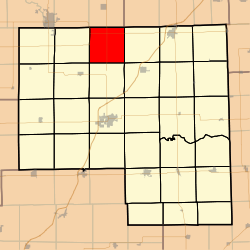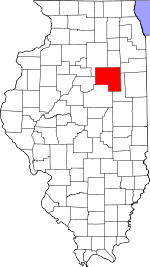Sunbury Township, Livingston County, Illinois
 From Wikipedia - Reading time: 11 min
From Wikipedia - Reading time: 11 min
Sunbury Township | |
|---|---|
Township | |
 Location in Livingston County | |
 Livingston County's location in Illinois | |
| Country | United States |
| State | Illinois |
| County | Livingston |
| Established | November 3, 1857 |
| Area | |
• Total | 36.5 sq mi (95 km2) |
| • Land | 36.5 sq mi (95 km2) |
| • Water | 0 sq mi (0 km2) 0% |
| Population (2010) | |
• Estimate (2016)[1] | 219 |
| • Density | 6.3/sq mi (2.4/km2) |
| Time zone | UTC-6 (CST) |
| • Summer (DST) | UTC-5 (CDT) |
| FIPS code | 17-105-73781 |
Sunbury Township is located in Livingston County, Illinois. As of the 2010 census, its population was 229 and it contained 103 housing units.[2]
Geography
[edit]According to the 2010 census, the township has a total area of 36.5 square miles (95 km2), all land.[2] The township consists primarily of farmland.
Demographics
[edit]| Census | Pop. | Note | %± |
|---|---|---|---|
| 2016 (est.) | 219 | [1] | |
| U.S. Decennial Census[3] | |||
History
[edit]Sunbury Township was named by William K. Brown after his former town in Pennsylvania. The township was organized April 6, 1858, by the election of J. O. Corey as supervisor; J. S. Cumming, clerk; T. F. Norton, assessor; A. S. Blakeslee, collector; Andrew Sprague, John Gower and R. C. Myer as commissioner of highways; Isaac Ames and A. J. Hopkins, constables. Only 19 votes were cast at the election.[4]
Early Settlers
[edit]The early settlers of Sunbury Township found mostly rolling prairie with little timber. Early settlement was primarily near Mud Creek in the southwest corner of the township.
Andrew Sprague was the first known settler in the township. He was a native of New York. He arrived in 1835 and located his claim in timber on the banks of Mud Creek. Andrew's brother, Ephraim, briefly settled in area before moving on.[4]
John V. Hilton settled in the area in 1842 making the journey overland from Buffalo, New York. He was a soldier in the War of 1812.[4]
Jacob Longnecker and his family arrived in the township in 1844. He was born in Pennsylvania, but had lived several years in Kentucky and Indiana. He traveled overland with horse and oxen, bringing his sheep, cattle and hogs with him. He first lived in a cabin which had been erected by Ephraim Sprague. He and his son Sylvester built a new home and the cabin was converted into a blacksmith shop.[5]
E. G. Rice settled in the area in 1847. He was a native of Maine which he left in 1845 staying a year in Michigan and then a year in Kendall County, Illinois. He would later move on to southern Illinois. His son, George, became a resident of Pontiac, Illinois.[6]
Luther Smith also arrived in 1847. He settled out on the prairie two miles south of where the town of Blackstone is now located. His farm had always been known as "Smith’s Mound."[7]
James Hill and family and James P. Hadley and wife settled in 1848. Hadley was one of the organizers of the township and assisted in appraising the school lands in 1853. The lands ranging from $5 to $8 per acre in value. He also assisted in organizing the districts of road and school purpose. John Blackmore and son Henry came here in 1849, having previously lived in Danville and Ottawa, Illinois.[7]
Asa Blakeslee, Thomas F. Norton, B. F. Norton, Isaac Ames, J. O Corey, Erastus Corey, Ansel Gammon, M. W. Gammon and C. D. Gammon were among the settlers in the years 1852–53. Blakeslee took up a claim on the prairie in the central part of the township where there were no other settlers. He bought 200 head of cattle since there was plenty of empty pastureland. He bought lumber in Ottawa, Illinois that he transported to his claim to build his home and farm buildings.[8]
Thomas F. Norton was a native of Maine and settled in the northeastern part of the township. After a short residence in the township, he was elected county surveyor in 1854 and served as township assessor 1858 to 1861. He also served as school treasurer. In 1862, Norton was ordained a minister of the Baptist church. Isaac Ames was also a native of Maine. He served as supervisor in 1861 and 1864, and as collector in 1859.[9]
J. O. Corey and his brother Erastus were from Pennsylvania. J. O. Corey had been an officer in the Mexican War. He was the first Supervisor of Sunbury Township, being elected in 1858. He also held the office 1874 to 1876. He moved on to Iowa in 1876. Erastus was a carpenter who came to the area in the employ of the railroad. He later returned to his home state.[9]
In 1854, two railroads, the Chicago & Alton and the Illinois Central, were completed through central Illinois. This opened the area to immigrants and also to the laborers who had worked on the railroad line construction.[10]
Anderson Corbin and Oliver Corbin arrived in April 1855 from Virginia. For several years they were the village blacksmiths. John Gower and his son Bailey A. Gower arrived from LaSalle County about 1856. They were natives of Maine. The former was supervisor in 1859, 1860 and 1863, and the latter during the years of 1866 and 1869.[11]
Erastus Thatcher and H. H. Brower also arrived in 1855. Brower was a lawyer and practiced in the courts of the county. He served as supervisor during the years 1862 and 1868.[11]
At the first election for county officers held November 6, 1858, there were 34 votes cast in the township. At the judicial election held in May of the following year, 48 votes were cast. The census of 1870 gave the township 891 inhabitants.[11]
Education
[edit]Schools
[edit]The first school house in the township was built in 1836 near the Sprague homestead. The first teacher was Catharine Sprague, mother of Andrew and Ephraim. This was twenty years before the state public school system was adopted. The school was private and maintained by subscription. The Hilton school was built in 1855 and the Ames school in 1856.
The report of Thomas F. Norton, the first school treasurer, shows that “in 1855 there was but one school, thirty-four scholars in attendance, ninety-two children in the township, and but one teacher; the highest wages paid was $12 per month, and the whole amount paid out for school purposes was $38.75; there were but 107 school books in all the houses, sixty-five of which were elementary spellers.”[11]
Post Office
[edit]In the early years, the settlers received their mail at the little post office in Esmen Township which was on the mail route from Danville to Ottawa, Illinois. The post office was called Sunbury and kept at the William K. Brown residence. It was afterward moved to the home of Andrew Sprague. In 1870, when the town of Blackstone was established in Sunbury Township, the post office was moved there.[12]
Cemeteries
[edit]There are three cemeteries in the township – Blackstone cemetery, located one-half mile west and one-half mile south of the village; Jones’ cemetery, located in the southeast quarter of section 21; Hadley cemetery, located in the southwest quarter of section 33.
Churches
[edit]The United Methodist Church in Blackstone was built in 1879. St. Bernard's Catholic Church was built in 1880 on the northeast quarter of section 10, one-half mile south of the village of Budd.[13]
Railroads
[edit]There were two railroads that crossed the northern section of Sunbury Township. The western extension of the Chicago & Alton Railroad passed through Blackstone and the Three-I Railroad (now CSX) passed through Budd.[14]
Communities
[edit]Points of Interest
[edit]- Sunbury Railroad Prairie Nature Preserve
Notes
[edit]- ^ a b "Population and Housing Unit Estimates". Retrieved June 9, 2017.
- ^ a b "Population, Housing Units, Area, and Density: 2010 - County -- County Subdivision and Place -- 2010 Census Summary File 1". United States Census. Archived from the original on February 12, 2020. Retrieved May 28, 2013.
- ^ "Census of Population and Housing". Census.gov. Retrieved June 4, 2016.
- ^ a b c History of Livingston County, 1909 p. 828
- ^ History of Livingston County, 1909 pp. 828-829
- ^ The History of Livingston County, Illinois, 1878 p. 557
- ^ a b History of Livingston County, p. 829
- ^ The History of Livingston County, Illinois, 1878 pp. 557-558
- ^ a b History of Livingston County, 1909 p. 829
- ^ The History of Livingston County, Illinois, 1878, p. 558
- ^ a b c d History of Livingston County, 1909, p. 829
- ^ The History of Livingston County, Illinois, 1878, p. 560
- ^ A History of Livingston County, Illinois, 1991, pp. 14-15
- ^ History of Livingston County, 1909, p. 830
References
[edit]- Historical Encyclopedia of Illinois and History of Livingston County, Edited by Newton Bateman, Paul Selby, Christopher C. Strawn, Fordyce B. Johnson and George H. Franzen; Munsell Publishing Company, Chicago, 1909
- The History of Livingston County, Illinois, Illustrated; Published by Wm. Le Baron, Jr., & Co., Chicago, 1878
- A History of Livingston County, Illinois; Compiled by the Livingston County History Project; Printed and Published by Curtis Media Corporation, 1991
 KSF
KSF